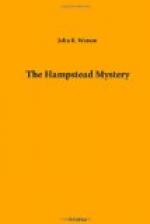It was the morning after Crewe’s visit to Riversbrook, and the detective sat in his private office glancing through a note-book which contained a summary of the Hampstead mystery. Crewe was a painstaking detective as well as a brilliant one, and it was his custom to prepare several critical summaries of any important case on which he was engaged, writing and rewriting the facts and his comments, until he was satisfied that he had a perfect outline to work upon, with the details and clues of the crime in consecutive order and relation to one another. Experience had taught him that the time and labour this task involved were well-spent. If an unexpected development of the case altered the facts of the original summary Crewe prepared another one in the same painstaking way. The summaries, when done with, were methodically filed and indexed and stored in a strong room at the office for future reference, where he also kept full records of all the cases upon which he had been engaged, together with the weapons and articles that had figured in them: huge volumes of newspaper reports and clippings; photographs of criminals with their careers appended; and a host of other odds and ends of his detective investigations—the whole forming an interesting museum of crime and mystery which would have furnished a store of rich material for a fresh Newgate Calendar. It was an axiom of Crewe’s that a detective never knew when some old scrap of information or some trifling article of some dead and forgotten crime might not afford a valuable clue. Expert criminals frequently repeated themselves, like people in lesser walks of life, and Crewe’s “library and museum,” as he called it, had sometimes furnished him with a simple hint for the solution of a mystery which had defied more subtle methods of analysis.
Crewe, after carefully reading his summary of the murder of Sir Horace Fewbanks, and making a few alterations in the text, drew from his pocket the glove which Inspector Chippenfield had handed him as a clue, took it to the window, and carefully examined it through a large magnifying glass. He was thus engrossed when the door was noiselessly opened, and Stork, the bodyguard, entered. Stork belied his name. He was short and fat, with a red mottled face; a model of discretion and imperturbability, who had served Crewe for ten years, and bade fair to serve him another ten, if he lived that long. In his heart of hearts he often wondered why a gentleman like Crewe should so far forget what was due to his birth and position as to have offices in Holborn—Holborn, of all parts of London! But the awe he felt for Crewe prevented his seeking information on the point from the only person who could give it to him, so he served him and puzzled over him in silence, his inward perturbation of spirits being made manifest occasionally by a puzzled glance at his master when the latter was not looking. It was nothing to Stork that his master was a famous detective; the problem to him was why he was a detective when he had no call to be one, having more money than any man—and let alone a single man—could spend in a lifetime.




